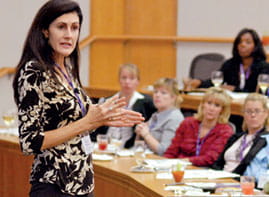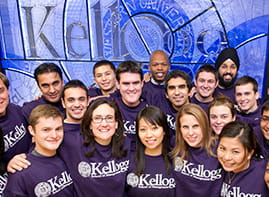A new study by Brian Gunia explores the impact of seating arrangements on group performance and dynamics
8/13/2010 - Creating harmonious teams doesn’t solely depend on the talent or output of individuals. It also has to do with the seating arrangements of groups, according to new research from the Kellogg School.
“Did I Do That? Group Positioning and Asymmetry in Attributional Bias,” a new study by Brian C. Gunia, a PhD candidate in Management and Organizations (MORS), and Brice Corgnet of the Universidad de Navarra in Navarra, Spain, demonstrates that where individuals sit in a group can impact how much they think they contributed to the group’s output. The study will appear in a forthcoming issue of
Negotiation and Conflict Management Research dedicated to group asymmetry.
Because disagreements about contributions often lead to group conflict, the research shows that different seating plans can improve the overall functioning of a group. In particular, it suggests that helping group members to see one another can also help them see “eye-to-eye.”
Psychological research has long shown that one motivator of group conflict is “self-serving attributional bias,” in which people give themselves more credit, especially for positive outcomes, than is rightfully due. Increasing group effectiveness and minimizing group conflict thus requires mitigating the bias. Gunia and Corgnet argue that group seating positions may foster bias when they prevent particular group members from seeing the contributions of others. Conversely, seating positions that increase the visibility of others can mitigate bias.
“Our paper explores the possibility that perceived contributions and subsequent dissatisfaction within a group may depend on the way the group is seated,” said Gunia. “Specifically, we examined whether those who could better see their colleagues’ contributions had more appreciation for the work of team members, and if they subsequently felt better when their colleagues claimed credit.”
As part of the study, three-person groups seated in rows were asked to complete a numbers task. It required them to identify as many numbers as possible that met complex, predetermined conditions — using a shared instruction sheet and answer sheet to encourage collaboration. The participants were then isolated and asked to fill out a questionnaire about their relative contribution to the group, as well as the contributions of the other group members. To measure each group member’s perceived contribution to the group, the participants were asked to give a percentage estimate of their individual contribution.
The findings revealed that the person seated in the middle routinely took approximately one-third of the credit for the task — his or her “fair share” of credit on average — while the other two (outside) participants took substantially more credit (about 45 percent). Notably, outside members undervalued contributions made by the other outside member, believing that this person contributed less than one-third, but they appropriately valued the contributions of the middle member. Meanwhile, middle members appropriately valued the contributions of both outside members. These results suggested that an inability to see other group members was, indeed, the driver of people’s credit judgments.
“These last findings are consistent with the visual access members had to the people in the other seats,” said Gunia. “People consistently appreciated their ‘neighbor’ and underappreciated those far away.”
Overall, the results showed that group members seated in the middle showed less bias than outside members because they had better visibility into their peers’ contributions. Also, despite differences in attributional bias based on positioning, group members in all positions were equally satisfied with the group experience. More generally, the research findings suggest that positioning groups so that the members can easily see one another (e.g., in a circle) may foster group harmony.
“This research suggests that circular arrangements or open-floor plans could minimize group conflict, something that managers might consider when calling team meetings,” said Gunia.
To arrange an interview with Brian Gunia, contact Meg Washburn at 847-491-5446 or m-washburn@kellogg.northwestern.edu.






